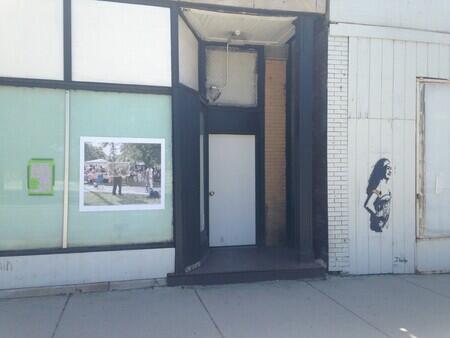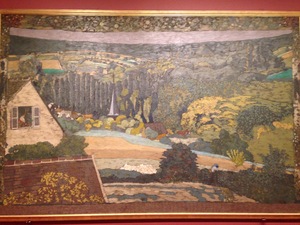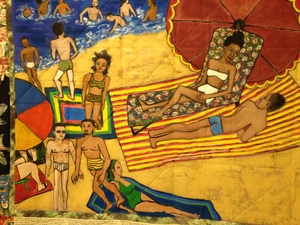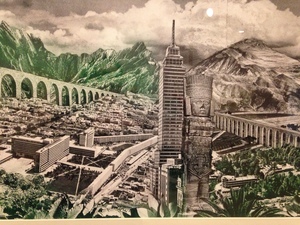Vidura Jang Bahadur Two Photographs Outside
Monday, May 11, 2020

Photograph and installation, Vidura Jang Bahadur, 2017, E. Garfield Street, Chicago. Under the painted portrait, signature, Devíons. Documentation photograph, Rachel Cohen.
On Friday I wrote about a show of works by photographer Vidura Jang Bahadur that has stayed with me. It was up in the spring of 2017 at the Muffler Shop at 359 E. Garfield in a University of Chicago-owned space here on the South Side. When I looked at the show, I began with the works that had been displayed in the interior space first, and my Friday entry concentrated mostly on those. Two works mounted outside were especially interesting, and I wanted to return to them today.
The Muffler Shop sits in a paved parking area with some green overgrown grasses around it. This is a photo I took of the Muffler Shop that day.

Past the grasses, there is a fence that connects to the next building, which is a set of storefronts in front of which there is a bus stop. When I was looking, there were a couple of people coming and going; one, I’m pretty sure, sitting at the bus stop. This photograph was on the side of the building, so you could see it as you left the Muffler Shop.


Looking at my images of the Bahadur installation over the last week, I’ve been struck by both the message painted within the photograph and the effect of it on this wall. It’s a photograph of a wall near a driveway or alley, very like the wall on which it is mounted. This close doubling makes you pay attention. It's also a photograph of a painted sentence, a photograph of a painting. Someone had spray-painted the stenciled letters “IF YOU WANT THE STORE TO OPEN STOP THE VIOLENCE.” Then the word, in a more italicized font, CONTACT, and a phone number.

Who is the “you” in the sentence? It seems directed at the immediate neighborhood, the people who might pass the wall, but the stenciled letters, the way there seems to be a slight rise in the “YOU” and a space, something odd about the “W” that begins “WANT” to my eye and ear makes a slight disjuncture and into this space floods the possibility of other you’s, the local government officials, the lax gun laws, the prison complex, the people who shuttered the neighborhood schools. It seems to me also about history, the history of redlining in the neighborhood, the history of voracious demand: labor, buy. Not only immediate sharp violence, but slow violence.

Today, a few of the main stories in the news are: coronavirus in the White House, the question of economic reopening, and the murder of Ahmaud Arbery. In this context, the message on the wall – If you want the store to open, stop the violence – seems a more profound analysis. The extreme callousness of the people in our nation’s first, and very white, storefront, the instrumental view of violence and suffering, just a part of the policy arsenal, the idea that you can force a healthy economy by coercing impoverished people into dangerous workplaces, and the delusion that this unnecessary squandering of peoples’ lives is not then a part of your own house, all of our houses – I find all this in the photograph today.

I’m also interested in the material. The desaturated concrete wall in the photograph next to the bricks and mortar on the wall. I see both with real consciousness of the material of which an ordinary day is made.

And even a photograph like this one that I took, which might seem like a formal study – painted wall, photographed, made into photograph on wall, itself photographed – seems less like a set of formal boxes, and more like a question of matter – the little tear in the paper that has been wheat pasted to the wall, the bends in the wire on the fence beneath.
**
Second photograph. On the glass window of the storefront, the green poster for the exhibition of work by MFA students from the University of Chicago in which Vidura Jang Bahadur’s work appeared. [I came to know Vidura Jang Bahadur because both of us came to work at the University of Chicago around the same time – he from many years photographing in India, China, and Tibet, me from New York and Cambridge.] The show was called “and…and…and.” Next to the green poster was Bahadur's photograph, which has, in the years since, become the one from the show that is most important to me. And on the other side of the door, there was a painting on the wall, which looked spray-painted, of a woman, smiling, her upper body. This was signed Devíons.

I suppose there might be different ideas about the way the art is joined together here, and, and, and, but to me it seemed like an attempt to acknowledge that the space being used by the University of Chicago was a part of neighborhood artistic life, already ongoing, that the new additions might intrude, and might also offer, you could decide.

The photograph was taken on the sidelines of the Bud Billiken Parade in 2016. There are the kind of open tents that get set up for selling things, for food. There is a man holding a framed print of a historical painting, which I imagined he might have made or purchased (though I later learned that he intended to sell it). It is a painting of four leaders – Nelson Mandela, Barack Obama, Dr. Martin Luther King, Jr., and Malcolm X. They are in a graceful, illuminated, classical space, seated at a table, drinking coffee or tea together, behind them arches, vines, and a statue that looks like it is a classical sculpture of a woman. It is a history painting, and, as all history paintings are, it is an argument about future understanding. Next to the photograph is a young woman who seems to me clearly aware that she is being photographed.

By looking at my own detail photographs of the Bahadur photograph, I become aware of things I didn’t see originally. I had the impression that the man holding the painting was obscured from the waist up, but I see that you can see the top of his head, even down to the eyebrows, and three fingers of his hand underneath the painting, and that these aspects of his presence give him a bit more agency. I feel more clearly that he wanted his painting photographed. And, behind the young men who are gesturing in the foreground, I see another man facing the camera, in a black shirt, and with a hat with a black band on it, and his looking at the photographer also adds to my sense that all these people made this picture together.

**
Both photographs, to me today, are about photographing history painting. The photographer who has mounted these photographs on this wall and in this window is thinking about the way people are making culture as they go. Both are about what can be there to see if you look closely, with what gets called “the big picture” in the back of your mind. Both are about granular matter – spraypaint, mortar, wheat paste, pigment, denim, polyester, visor, paper, canvas, straw, concrete.












